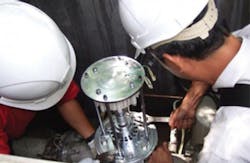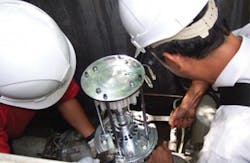Novel Technology Generates Hydro Power from Flow In Small Pipes
Source: Institute for Entrepreneurship, The Hong Kong Polytechnic University
Generating electricity from water is not a new thing. Hydro power stations have already sprung up across the world in China, the United States, and Canada. However, scientists will not stop exploring advanced technologies for further improvement to benefit people’s lives.
Recently, PolyU’s Department of Building Services Engineering and the Water Supplies Department (WSD) of the Hong Kong Special Administrative Region Government have been working together to turn water mains into an alternative source of power.
Hong Kong has a network of water mains travelling over 7,800 km, which is comprehensively monitored by WSD using monitoring devices to make sure the water supply remains clean and well-maintained. Water mains need power for those devices. Conventionally, small turbines are put into the pipes to produce electricity from drinking water.
The water main pipes present a real challenge; they are just one meter across and hold far less water volume and potential energy compared to giant water dams, for example. In pushing the boundaries, specialists in hydrodynamics, mechanical engineering and renewable energy have created a highly efficient device in harnessing the power of water. The resulting turbine is small enough to fit into a pipe, and uses just a fraction of hydro-energy to generate about 80 volts, enough to power four compact fluorescent light bulbs.
The novel device consists of an external hydroelectric generator and highly efficient spherical water turbine, which dips into flowing water and reclaims residual pressure. When water passes through, the turbine drives a central rotating shaft and a micro generator to produce electricity.
The key lies in a number of intelligent designs to extract more energy from flowing water. The eight-blade turbine would only take away a fraction of kinetic energy because it strikes an accurate balance between water volume, water pressure, and consumption of hydrokinetic energy, which boosts efficiency without reducing the momentum of running water to guarantee a reliable water supply. Turbine blades are carefully sized to intersect the largest possible area of water flow and minimize water bypassing.
To achieve maximum power output, a revolutionary design made the central rotating shaft hollow on the inside to minimize energy losses when driving the generator and utilize the harvested energy in full. The team also made the water more energetic and produced a strong current with a special metal block placed at the center of the pipe to compress and accelerate the water flow. To further protect our drinking water, the turbine does not have moving parts and does not need any lubricant to eliminate the slightest change of contamination.
The mini-hydro power system has been put to test in a number of locations including underground pits and outdoor environments. The principal investigator, Prof. Hong-xing Yang from Department of Building Services Engineering commented, “We have made the water pipes self-sufficient.” In full operation, an array of in-pipe turbines is expected to save 700kWh of electricity and reduce 560 kg of carbon dioxide emission per year.
It is not only a green innovation to further cut our reliance on coal-based power plants, but also an engineering triumph that gives WSD an easy access to electricity in areas without power grid, such as treacherous terrains and underground. “This technology also points to viable turbine solutions for waters that have little potential for energy generation,” added Prof. Yang.
The invention won a Silver Medal at the 40th International Exhibition of Inventions of Geneva in Switzerland.
Source: Institute for Entrepreneurship, The Hong Kong Polytechnic University

